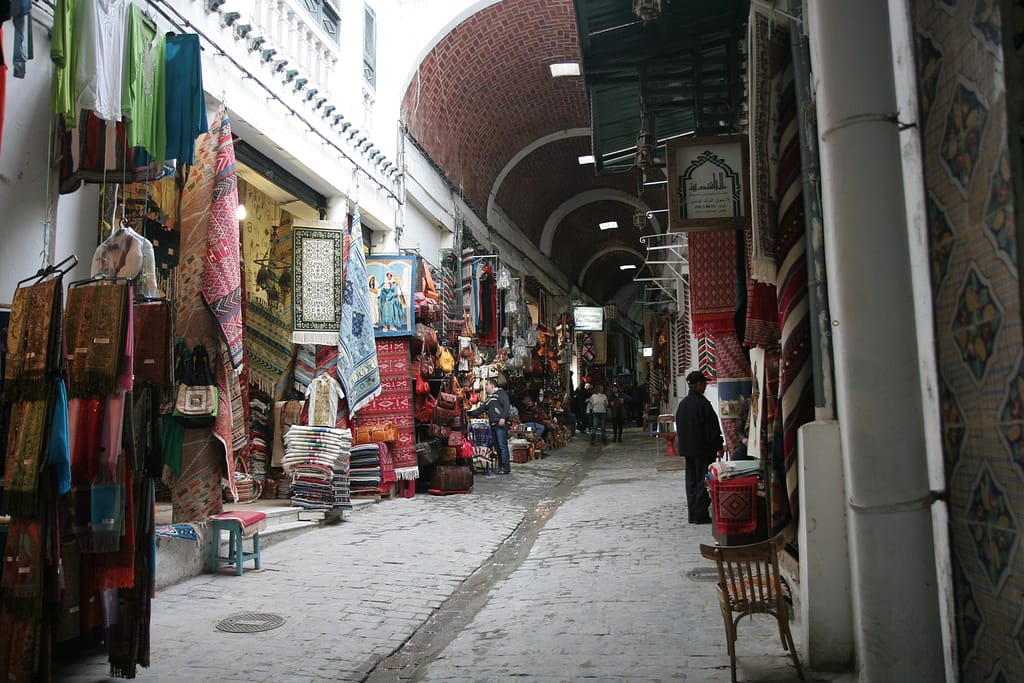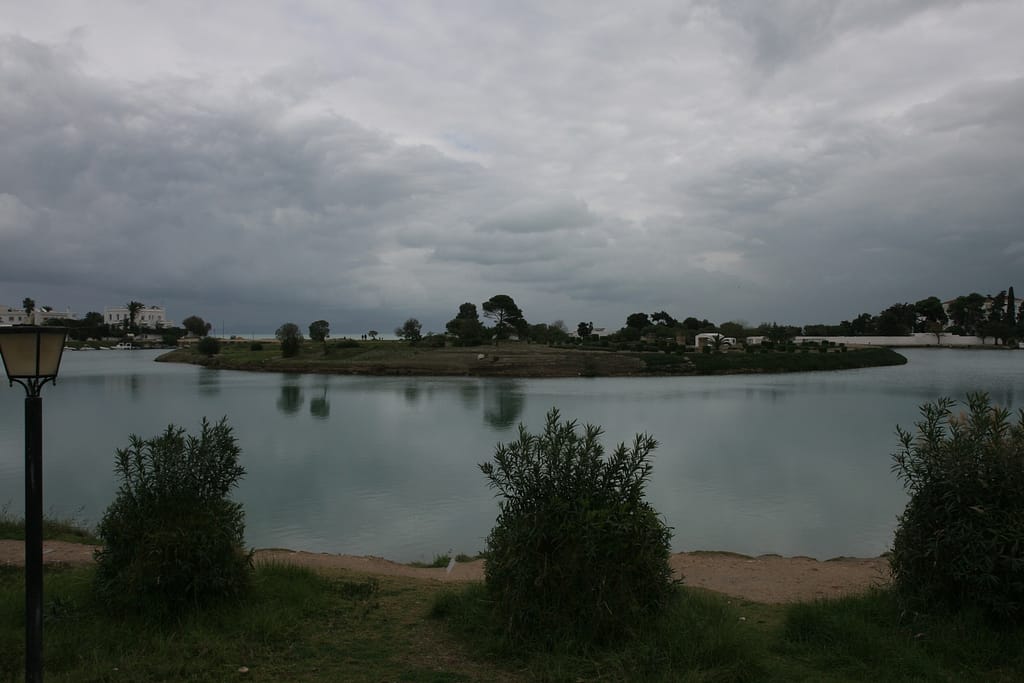Amphitheatre of El Jem
Date of Inscription: 1979
N35 17 47.004 E10 42 24.984

El Jem is famous for its amphitheatre, capable of seating 35,000 spectators. Only Rome’s Colosseum (about 45,000 spectators) and the ruined theatre of Capua are larger. The amphitheatre at El Jem was built by the Romans under proconsul Gordian, who was acclaimed Emperor at Thysdrus, around 238. Due to a lack of money the site was never finished. Until the 17th century it remained more or less whole. From then on its stones were used for building the nearby village of El Jem and transported to the Great Mosque in Kairouan, and at a tense moment during struggles with the Ottomans, the Turks used cannons to flush rebels out of the amphitheatre. Nowadays you can still see where the cannon balls hit.
Medina of Tunis
Date of Inscription: 1979
N36 49 0.012 E10 10 0.0124

The Medina contains some 700 monuments, including palaces, mosques, mausoleums, madrasas and fountains dating from the Almohad and the Hafsid periods. Tunis was considered one of the wealthiest places in the Islamic world. These ancient buildings include: The Great Mosque (including the Muslim University and library), Aghlabid Ez-Zitouna Mosque (built in 723 by Obeid Allah Ibn-al-Habhab to celebrate the new capital) The Dar-al-Bey Palace (comprises architecture and decoration from many different styles and periods and is believed to stand on the remains of a Roman theatre as well as the tenth century palace of Ziadib-Allah II al Aghlab).
Site of Carthage
Date of Inscription: 1979
N36 51 10.008 E10 19 23.988

Carthage refers both to an ancient city in present-day Tunisia, and a modern-day suburb of Tunis. The civilization that developed within the city’s sphere of influence is referred to as Punic or Carthaginian. The city of Carthage is located on the eastern side of Lake Tunis across from the center of Tunis. According to Roman legend it was founded in 814 BC by Phoenician colonists under the leadership of Elissa (Queen Dido). It became a large and rich city and thus a major power in the Mediterranean. The resulting rivalry with Syracuse and Rome was accompanied by several wars with respective invasions of each other’s homeland. Hannibal’s invasion of Italy in the Second Punic War culminated in the Carthaginian victory at Cannae and led to a serious threat to the continuation of Roman rule over Italy; however, Carthage emerged from the conflict at its historical weakest. After the Third Punic War, the city was destroyed by the Romans in 146 BC. However, the Romans refounded Carthage, which became one of the three most important cities of the Empire and the capital of the short-lived Vandal kingdom. It remained one of the most important Roman cities until the Muslim conquest when it was destroyed a second time in AD 698. It was believed that the Romans erased all traces of Punic Carthage. But preserved under the Roman forum are the unique remains of the homes of ordinary Carthaginians.
Ichkeul National Park
Date of Inscription: 1980
N37 9 48.996 E9 40 28.992

The Ichkeul lake and wetland are a major stopover point for hundreds of thousands of migrating birds, such as ducks, geese, storks and pink flamingoes who come to feed and nest there. Ichkeul is the last remaining lake in a chain that once extended across North Africa. This National Park was on the Unesco’s list of sites in danger. Due to governmental interference the salinity is being reduced. The lake and the wetlands were removed from the sites in danger list in 2006.
Punic Town of Kerkuane and its Necropolis
Date of Inscription: 1985
N36 56 47.004 E11 5 57.012

Kerkuane is a Punic city in northeastern Tunisia, near Cape Bon. This Phoenician city was probably abandoned during the First Punic War (c. 250 B.C.), and as a result was not rebuilt by the Romans. It had existed for almost 400 years. Excavations of the town have revealed ruins from the 4th and 3rd Centuries BC. Around the site where the layout is clearly visible, many houses still show their walls, and the colored clay on the facades is often still visible. The houses were built to a standard plan, in accordance with a sophisticated notion of town planning. A sanctuary has some columns preserved, and in a small atrium parts of mosaics are found. Curbstones, doorsteps, thresholds, and floors of simple mosaic layers are found all over the ruins. Still archaeologists work on the Kerkuane site, but it is believed that the best parts have already been discovered.
Kairouan
Date of Inscription: 1988
N35 40 54.012 E10 6 14.004

After its establishment in the 7th century, it became an important center for Islamic and Quranic learning, and thus attracted a large number of Muslims from various parts of the world, next only to Mecca and Medina. The holy Mosque of Uqba is situated in the city. In 2003 the city had about 150,000 inhabitants. In 2009 Kairouan was the Islamic Cultural Capital.
Medina of Sousse
Date of Inscription: 1988
N35 49 40.008 E10 38 18.996

Despite the turmoil around it, Sousse’s character had retained the solidly Arabian look and feel it had assumed in the centuries after Islam’s wars of conquest. Today it is considered one of the best examples of seaward-facing fortifications built by the Arabs. Its ribat, a soaring structure that combined the purposes of a minaret and a watch tower, is in outstanding condition and draws visitors from around the world. These days, Sousse, with a population of more than 540,000, retains a medieval heart of narrow, twisted streets, a kasbah and medina, its ribat fortress and long wall on the Mediterranean. Surrounding it is a modern city of long, straight roads and more widely spaced buildings.
Thugga
Date of Inscription: 1997
N36 25 24.996 E9 13 13.008

The best-preserved Roman small town in North Africa. Thugga is a Roman ruin in northern Tunisia located on a 65 hectare site. The site, which lies in the middle of the countryside, has been protected from the encroachment of modern urbanization, in contrast, for example, to Carthage, which has been pillaged and rebuilt on numerous occasions. Thugga’s size, its well-preserved monuments and its rich Punic, Numidian, ancient Roman and Byzantine history make it exceptional. Amongst the most famous monuments at the site are a Punic-Libyan mausoleum, the capitol, the theatre, and the temples of Saturn and of Juno Caelestis.